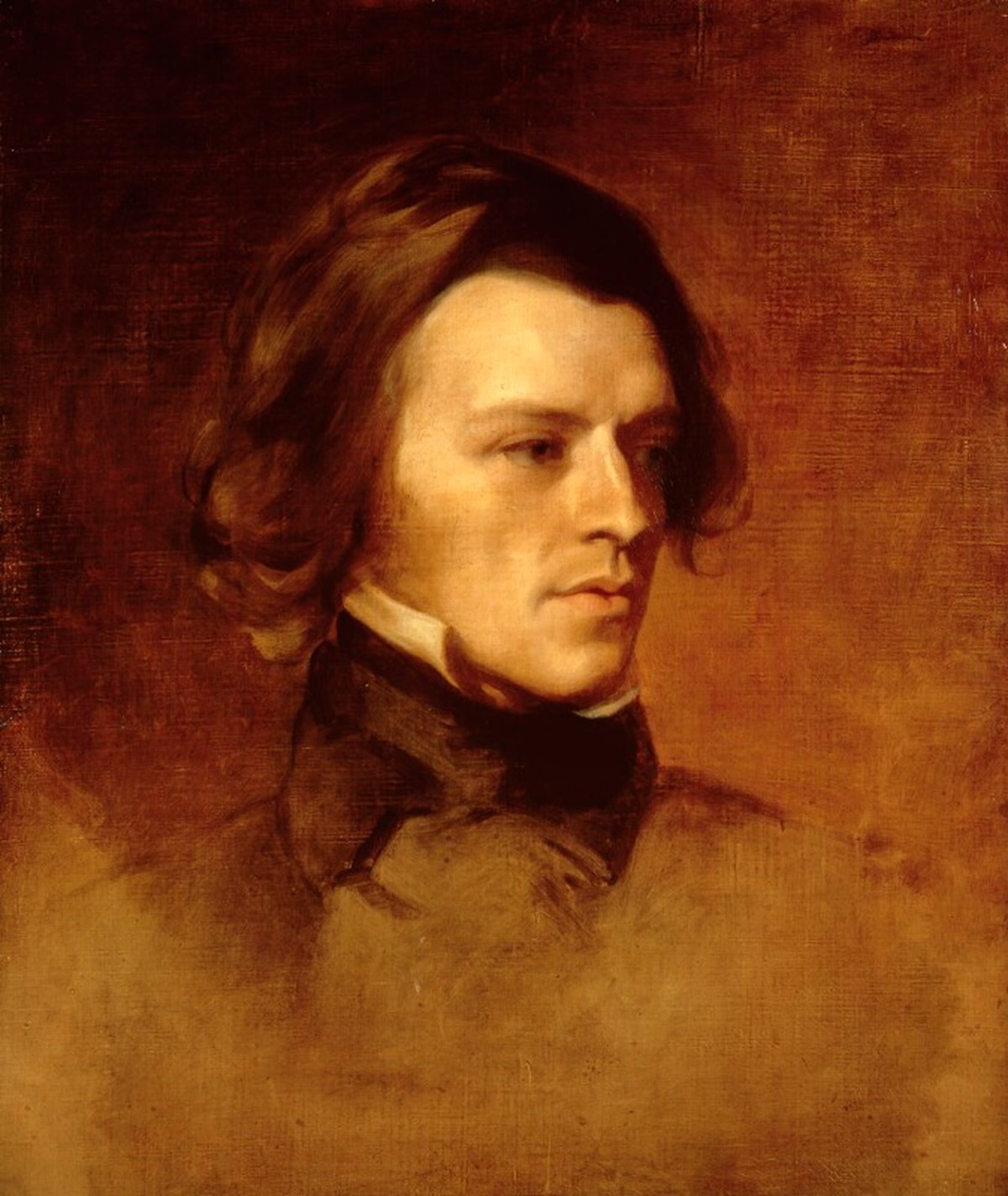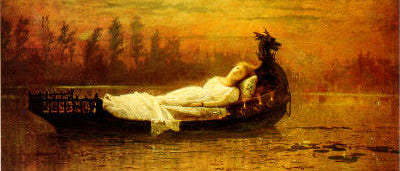Alfred, Lord Tennyson: The Lady of Shalott
Posted on 9th March 2022
There was no greater poet of the Victorian Era than Alfred, Lord Tennyson. His poems epic of theme and mournful in style struck a chord in a country that may have been busy with Empire building and creating the modern world but remained obsessed with the past; a nostalgia borne of a life often nasty, brutish and short regardless of background and where industry scarred the landscape and poverty and disease was everywhere to be seen. An environment that lent itself to sentimentalism and no poet satisfied this desire more than Tennyson. He was in W.H Auden’s words the “Great master of melancholia.”
Born in 1809, into a large family in the Lincolnshire village of Somersby where his father was Rector plain Alfred Tennyson, who was perhaps influenced in his melancholia by the flat landscape and lowering skies of his home county, spent much of his childhood in his father’s well stocked library; his refuge perhaps from a man known to be a heavy drinker and of ill-temper, but one who had taken care to ensure his children were provided with a good education.

In 1827, he attended Trinity College, Cambridge where he soon became a prize- winning student but had to leave before graduation due to financial difficulties following his father’s death. Upon his return home he co-authored alongside his brother a short book of poems.
He was now mostly kept busy running the family household but in 1833 was able to publish a second book of poems that was all his own work. It was not well received, and he would not publish any further poems for a decade. One of its poems would prove more enduring and influential than he might have imagined however, and over time would also become one of his most popular.
The Lady of Shallot is a lyrical ballad that tells the Arthurian legend of Elaine of Astalot whose unrequited love for Sir Lancelot sees her cursed on pain of death to remain in a tower and weave. She never again could set her eyes upon the world only see it reflected in a mirror. In the end, unable to bear it any longer she escapes her isolation and sets off in a boat to Camelot hoping to see beloved Sir Lancelot. But the curse is indeed of a deadly provenance. Informed of her tragic death Sir Lancelot pays his respects and looking upon her face remarks how lovely she was.
The Arthurian Legends were an abiding interest of Tennyson’s as indeed was English mythology to many Victorians. The Lady of Shalott would be revised and reissued fifteen years later as part of his Idylls of the King, a book of twelve narrative poems re-telling the story of King Arthur and the Knights of the Round Table. It would have a great influence on the medievalist inspired Pre-Raphaelite Brotherhood of Dante Gabriel Rossetti, William Holman Hunt and John Everett Millais among others; and also later artists such as John William Waterhouse and Edward Burne-Jones. Indeed, the Lady of Shalott was to be painted many times.

Yet despite being admired in both literary and artistic circles Tennyson struggled financially for many years and it wasn’t until he published In Memoriam A.H.H his requiem to his closest friend Arthur Henry Hallam who had died many years before and which has the famous lines, “’Tis better to have loved and lost/Than never to have loved at all,” that a career which had appeared to have stalled began to soar.
In Memoriam was a favourite poem of Queen Victoria who carried a copy of it on her person while her husband Prince Albert sent his copy to the author along with a letter requesting Tennyson sign it. Not long after the publication of In Memoriam he was appointed Poet Laureate following the death of William Wordsworth.
His reputation as Victorian Britain’s greatest poet was assured with the publication of his The Charge of the Light Brigade in 1854 which was not only critically acclaimed but made him hugely popular with the public at large for the first time.

Part I
On either side the river lie
Long fields of barley and of rye,
That clothe the wold and meet the sky;
And thro' the field the road runs by
To many-tower'd Camelot;
The yellow-leaved waterlily
The green-sheathed daffodilly
Tremble in the water chilly
Round about Shalott.
Willows whiten, aspens shiver.
The sunbeam showers break and quiver
In the stream that runneth ever
By the island in the river
Flowing down to Camelot.
Four gray walls, and four gray towers
Overlook a space of flowers,
And the silent isle imbowers
The Lady of Shalott.
Underneath the bearded barley,
The reaper, reaping late and early,
Hears her ever chanting cheerly,
Like an angel, singing clearly,
O'er the stream of Camelot.
Piling the sheaves in furrows airy,
Beneath the moon, the reaper weary
Listening whispers, ' 'Tis the fairy,
Lady of Shalott.'
The little isle is all inrail'd
With a rose-fence, and overtrail'd
With roses: by the marge unhail'd
The shallop flitteth silken sail'd,
Skimming down to Camelot.
A pearl garland winds her head:
She leaneth on a velvet bed,
Full royally apparelled,
The Lady of Shalott.
Part II
No time hath she to sport and play:
A charmed web she weaves alway.
A curse is on her, if she stay
Her weaving, either night or day,
To look down to Camelot.
She knows not what the curse may be;
Therefore she weaveth steadily,
Therefore no other care hath she,
The Lady of Shalott.
She lives with little joy or fear.
Over the water, running near,
The sheepbell tinkles in her ear.
Before her hangs a mirror clear,
Reflecting tower'd Camelot.
And as the mazy web she whirls,
She sees the surly village churls,
And the red cloaks of market girls
Pass onward from Shalott.
Sometimes a troop of damsels glad,
An abbot on an ambling pad,
Sometimes a curly shepherd lad,
Or long-hair'd page in crimson clad,
Goes by to tower'd Camelot:
And sometimes thro' the mirror blue
The knights come riding two and two:
She hath no loyal knight and true,
The Lady of Shalott.
But in her web she still delights
To weave the mirror's magic sights,
For often thro' the silent nights
A funeral, with plumes and lights
And music, came from Camelot:
Or when the moon was overhead
Came two young lovers lately wed;
'I am half sick of shadows,' said
The Lady of Shalott.
Part III
A bow-shot from her bower-eaves,
He rode between the barley-sheaves,
The sun came dazzling thro' the leaves,
And flam'd upon the brazen greaves
Of bold Sir Lancelot.
A red-cross knight for ever kneel'd
To a lady in his shield,
That sparkled on the yellow field,
Beside remote Shalott.
The gemmy bridle glitter'd free,
Like to some branch of stars we see
Hung in the golden Galaxy.
The bridle bells rang merrily
As he rode down from Camelot:
And from his blazon'd baldric slung
A mighty silver bugle hung,
And as he rode his armour rung,
Beside remote Shalott.
All in the blue unclouded weather
Thick-jewell'd shone the saddle-leather,
The helmet and the helmet-feather
Burn'd like one burning flame together,
As he rode down from Camelot.
As often thro' the purple night,
Below the starry clusters bright,
Some bearded meteor, trailing light,
Moves over green Shalott.
His broad clear brow in sunlight glow'd;
On burnish'd hooves his war-horse trode;
From underneath his helmet flow'd
His coal-black curls as on he rode,
As he rode down from Camelot.
From the bank and from the river
He flash'd into the crystal mirror,
'Tirra lirra, tirra lirra:'
Sang Sir Lancelot.
She left the web, she left the loom
She made three paces thro' the room
She saw the water-flower bloom,
She saw the helmet and the plume,
She look'd down to Camelot.
Out flew the web and floated wide;
The mirror crack'd from side to side;
'The curse is come upon me,' cried
The Lady of Shalott.
Part IV
In the stormy east-wind straining,
The pale yellow woods were waning,
The broad stream in his banks complaining,
Heavily the low sky raining
Over tower'd Camelot;
Outside the isle a shallow boat
Beneath a willow lay afloat,
Below the carven stern she wrote,
The Lady of Shalott.
A cloudwhite crown of pearl she dight,
All raimented in snowy white
That loosely flew (her zone in sight
Clasp'd with one blinding diamond bright)
Her wide eyes fix'd on Camelot,
Though the squally east-wind keenly
Blew, with folded arms serenely
By the water stood the queenly
Lady of Shalott.
With a steady stony glance—
Like some bold seer in a trance,
Beholding all his own mischance,
Mute, with a glassy countenance—
She look'd down to Camelot.
It was the closing of the day:
She loos'd the chain, and down she lay;
The broad stream bore her far away,
The Lady of Shalott.
As when to sailors while they roam,
By creeks and outfalls far from home,
Rising and dropping with the foam,
From dying swans wild warblings come,
Blown shoreward; so to Camelot
Still as the boathead wound along
The willowy hills and fields among,
They heard her chanting her deathsong,
The Lady of Shalott.
A longdrawn carol, mournful, holy,
She chanted loudly, chanted lowly,
Till her eyes were darken'd wholly,
And her smooth face sharpen'd slowly,
Turn'd to tower'd Camelot:
For ere she reach'd upon the tide
The first house by the water-side,
Singing in her song she died,
The Lady of Shalott.
Under tower and balcony,
By garden wall and gallery,
A pale, pale corpse she floated by,
Deadcold, between the houses high,
Dead into tower'd Camelot.
Knight and burgher, lord and dame,
To the planked wharfage came:
Below the stern they read her name,
The Lady of Shalott.
They cross'd themselves, their stars they blest,
Knight, minstrel, abbot, squire, and guest.
There lay a parchment on her breast,
That puzzled more than all the rest,
The wellfed wits at Camelot.
'The web was woven curiously,
The charm is broken utterly,
Draw near and fear not,—this is I,
The Lady of Shalott.'
Final Stanza (1842) Version
Who is this? and what is here?
And in the lighted palace near
Died the sound of royal cheer;
And they cross'd themselves for fear,
All the knights at Camelot:
But Lancelot mused a little space;
He said, "She has a lovely face;
God in his mercy lend her grace,
The Lady of Shalott."
Share this post:





